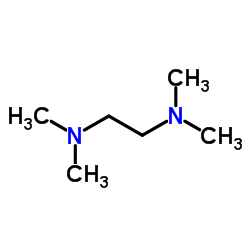TMEDA

TMEDA structure
|
Common Name | TMEDA | ||
|---|---|---|---|---|
| CAS Number | 110-18-9 | Molecular Weight | 116.205 | |
| Density | 0.8±0.1 g/cm3 | Boiling Point | 121.0±0.0 °C at 760 mmHg | |
| Molecular Formula | C6H16N2 | Melting Point | −55 °C(lit.) | |
| MSDS | Chinese USA | Flash Point | 10.0±0.0 °C | |
| Symbol |



GHS02, GHS05, GHS07 |
Signal Word | Danger | |
|
Aptamer-based polyvalent ligands for regulated cell attachment on the hydrogel surface.
Biomacromolecules 16(4) , 1382-9, (2015) Natural biomolecules are often used to functionalize materials to achieve desired cell-material interactions. However, their applications can be limited owing to denaturation during the material functionalization process. Therefore, efforts have been made to ... |
|
|
Polymerization of affinity ligands on a surface for enhanced ligand display and cell binding.
Biomacromolecules 15(12) , 4561-9, (2014) Surfaces functionalized with affinity ligands have been widely studied for applications such as biological separations and cell regulation. While individual ligands can be directly conjugated onto a surface, it is often important to conjugate polyvalent ligan... |
|
|
Kafirin adsorption on ion-exchange resins: isotherm and kinetic studies.
J. Chromatogr. A. 1356 , 105-16, (2014) Kafirin is a natural, hydrophobic and celiac safe prolamin protein obtained from sorghum seeds. Today kafirin is found to be useful in designing delayed delivery systems and coatings of pharmaceuticals and nutraceuticals where its purity is important and this... |
|
|
Use of an enzyme-assisted method to improve protein extraction from olive leaves.
Food Chem. 169 , 28-33, (2014) The improvement of protein extraction from olive leaves using an enzyme-assisted protocol has been investigated. Using a cellulase enzyme (Celluclast® 1.5L), different parameters that affect the extraction process, such as the influence and amount of organic ... |
|
|
Effects of pentylenetetrazole kindling on mitogen-activated protein kinases levels in neocortex and hippocampus of mice.
Neurochem. Res. 39(12) , 2492-500, (2014) The epileptogenesis process involves cell signaling events associated with neuroplasticity. The mitogen-activated protein kinases (MAPKs) integrate signals originating from a variety of extracellular stimuli and may regulate cell differentiation, survival, ce... |
|
|
Verification of a canine PSMA (FolH1) antibody.
Anticancer Res. 35(1) , 145-8, (2014) Canine prostate cancer (PC) is a highly aggressive malignancy. However, in contrast to man, neither standard screening strategies nor curative therapeutic options exist for the companion animal. A prostate-specific membrane antigen (PSMA) screening as molecul... |
|
|
Purification and characterization of a DNA-binding recombinant PREP1:PBX1 complex.
PLoS ONE 10(4) , e0125789, (2015) Human PREP1 and PBX1 are homeodomain transcriptional factors, whose biochemical and structural characterization has not yet been fully described. Expression of full-length recombinant PREP1 (47.6 kDa) and PBX1 (46.6 kDa) in E. coli is difficult because of poo... |
|
|
Mouse hepatocytes and LSEC proteome reveal novel mechanisms of ischemia/reperfusion damage and protection by A2aR stimulation.
J. Hepatol. 62(3) , 573-80, (2015) Ischemia-reperfusion (IR) of liver results in hepatocytes (HP) and sinusoidal endothelial cells (LSEC) irreversible damage. Ischemic preconditioning protects IR damage upon adenosine A2a receptor (A2aR) stimulation. Understanding the phenotypic changes that u... |
|
|
The Ca²⁺-calmodulin-Ca²⁺/calmodulin-dependent protein kinase II signaling pathway is involved in oxidative stress-induced mitochondrial permeability transition and apoptosis in isolated rat hepatocytes.
Arch. Toxicol. 88(9) , 1695-709, (2014) Oxidative stress (OS) is a common event in most hepatopathies, leading to mitochondrial permeability transition pore (MPTP) formation and further exacerbation of both OS from mitochondrial origin and cell death. Intracellular Ca²⁺ increase plays a permissive ... |
|
|
Cardiovascular disease-related parameters and oxidative stress in SHROB rats, a model for metabolic syndrome.
PLoS ONE 9(8) , e104637, (2014) SHROB rats have been suggested as a model for metabolic syndrome (MetS) as a situation prior to the onset of CVD or type-2 diabetes, but information on descriptive biochemical parameters for this model is limited. Here, we extensively evaluate parameters rela... |